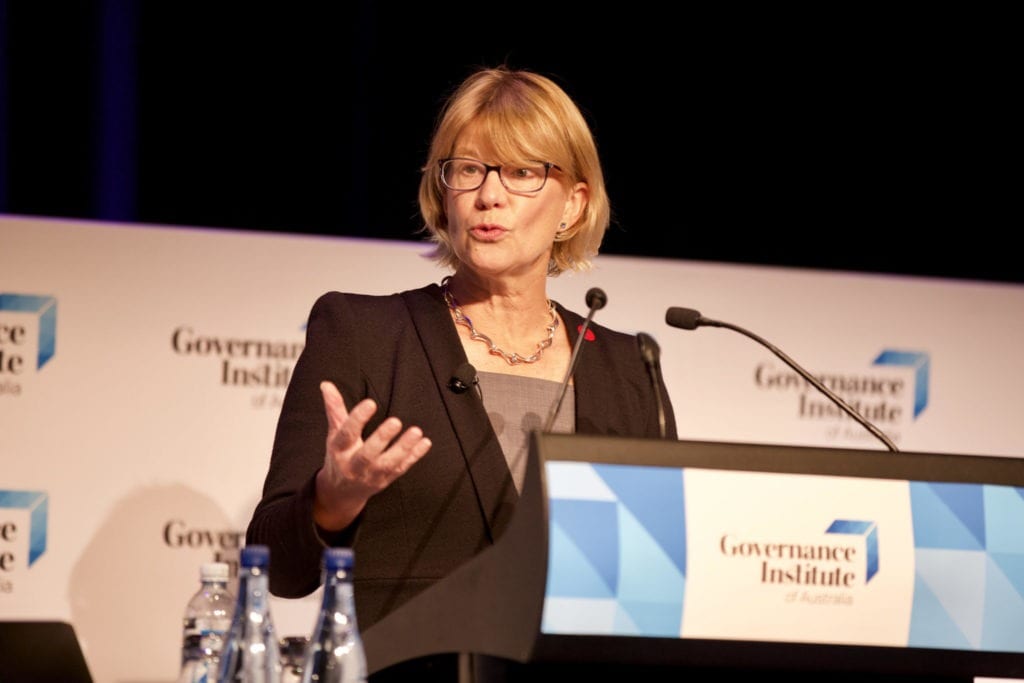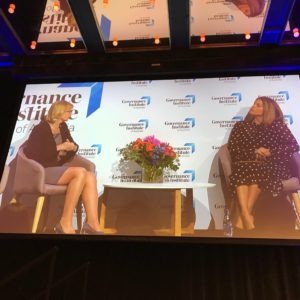Now at the helm of Coca Cola, she has been listed on Fortune’s international list of the 50 most powerful businesswomen in the world, and is one of Australia’s best known business leaders who is regularly sought out for advice.
Earlier this week, Women’s Agenda witnessed Watkins’ in action, as she was one of three keynote speakers on the first day of the National Governance Conference in Sydney, run by the Governance Institute of Australia.
Watkins told the crowd she believes organisations needs to function as smooth social systems, that are aware of how they’re influenced by industry, environment and society, as well as the distinctive style and personality of its leader. The relationship between management and board needs to be transparent for a company’s performance to optimise its future, Watkins said. How can these two bodies operate without compromising the accountability of management, she asked?
She believes there are five ingredients that characterise a well functioning eco-system between board and management team.
Watkins with MC Anjali Rao
1. Board and management teams need to be hyper-aligned. This means asking the right questions, such as “What is the company’s purpose?” and “Is the company achieving its purpose?” Most critically, it means asking, “What is your purpose, strategy and targets for the company and what are going to get done this year?”
It also means articulating the strategies you propose to take and ensuring routine and frequent reporting processes are designed and implemented, ranging on everything from regular communication and/or site visits to ensuring targets are met and reported. But ultimately, it’s about how the board and management function as a cohesive social system. “Routines and processes,” Watkins said, will ensure there is “no misunderstanding on how the board will operate.”
2. Trust between the board and management is paramount. “The CEO and Chairman set the tone,” Watkins said, adding that they must be aligned in their purpose and values for the company, aware of each others’ communication style and understand each others motivations. Establishing trust is inherent in any successful business operation, and authenticity is the stabilising pre-requisite. “Being authentic, honest and forthright,” Watkins asserts, “will allow trust to flourish.”
3. A good board includes members who are reflective and able to learn. This means recognising and acknowledging that we all have our blindspots, and that if you’re a director or chairman, understanding that you should be willing to have those around you point your own blindspots out for the company’s wellbeing. Watkins believes that a strong chairman asks and gives director feedback, but also asks for and gives management feedback too.
4. It behooves the board and management to have procedures and strategies in place to handle stress events. These can be class actions, takeovers, acquisitions, a strike or simply when a company is not achieving its forecasts. “No company is immune to these events and the real test of the strength is under this kind of adversity,” Watkins said.
When a stress event occurs, the chairman needs to step up and be prepared to roll up their sleeves, though “not try to be the expert.” Instead, Watkins says, “Be willing to show [you] don’t have all the answers and focus on making sure there is good process and advice.”
They also need to put their individual reputations and financial interests to the side and place “the company and its people first.” The whole board should be marshalled and establish a “clear understanding as to what authority is delegated to a sub-committee.”
5. Successful social systems between board and management understand the importance of the company’s purpose in the broader community. “Being a socially responsible corporation is not tangential to business, but fundamental to it,” Watkins said. What gives companies a competitive advantage? According to Watkins, such an advantage comes to those that have Boards that are alert to the long term impact of social issues and “are in constant dialogue with stakeholders, and act responsibility.
“Care and concern” was one of Watkins’ key focus mantras. “Lift and inspire each other by putting the company and its people first.”
Watkins has also been a Non-executive Director of Australia and New Zealand Banking Group Limited, Woolworths Limited and Just Group Limited. She is a former Victorian President and National Board Member of the Australian Institute of Company Directors and currently serves as Non-executive Director of The Centre for Independent Studies and of the Business Council of Australia.


